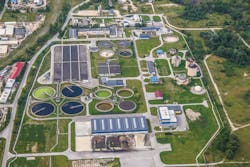The Changing Water Landscape
Nine Trends to Watch in 2019
By Reese Tisdale
Municipal water is arriving — if it has not already — at a crossroads at which long-established and proven water and wastewater utility management practices are being challenged. Calls for increased adoption of more advanced solutions — digital water, reclaimed water use, decentralized treatment — are forcing water service providers to take note. Certainly, these calls are partly being driven by hype but where there is smoke, there is usually fire.
It is no secret that financial demands on municipal and utility infrastructure are rising at an unsustainable pace. Existing assets in some cities are nearing the end of their useful lives, new housing starts in the United States have been rising at a 6.5 percent annual clip, and climatic shifts (e.g., drought, flooding, algae blooms) pose unforeseen risks to planning budgets. While these represent significant challenges, they are also opportunities to evolve into a more efficient system.
Bluefield Research’s water experts continue to track the deployment of innovative solutions and business models across the water landscape. As we prepare for 2019, Bluefield has identified the top 9 trends to watch in municipal water, outlined below.
Solutions providers are looking to operationalize historic data in asset-centric decision-making.
1. Financial Players Grab Stakes in Digital Water
Venture capital players continue to provide a key finance mechanism for solutions providers. Bluefield has tracked 193 investments since 2018, across 91 companies in 13 countries. These investments, now surpassing $815 million of disclosed deals, are being executed in an environment in which more advanced technologies are penetrating a mature water sector. This activity is highlighted by XPV’s buyout of Metasphere and Suez Ventures’ acquisition of Optimatics, reinforcing the water industry’s appetite for digital solutions.
2. OPEX Continues to Take on Greater Share of Total Expenditure Pie
The U.S. municipal water sector is seeing rising labor costs, increasing material prices, and growing demand to maintain aging, less efficient networks and plants. The impact has been an increase in annual operating expenditures (OPEX) by 57 percent since 1990. Over the next decade, Bluefield forecasts OPEX to reach almost $100 billion a year with annual increases surpassing 6 percent in a high-growth scenario.
Although capital expenditures (CAPEX) for U.S. municipal water are also on the rise, they are not rising at the same rate. Budgeted CAPEX for wastewater and stormwater infrastructure is on pace to exceed $680 billion over the next decade at more moderate 1.5 percent growth rate.
Without increased investment in utility infrastructure, ongoing operating costs to maintain will begin outpacing historic trends and CAPEX investments, placing additional burden on ratepayers who are already seeing rate increases in some cities exceeding double digits.
3. Smart Technologies Grow in Adoption to Address Legacy Water System Issues
Improved asset management could be a game-changer for municipal water markets. Players from across the utility operating spectrum are extending their offerings to incorporate asset-centric products and services. From multiple angles (leak detection, pressure management, workflow management), solutions providers are looking to operationalize historic data in asset-centric decision-making. Smarter, more advanced asset management strategies will help water utilities avoid $41.9 billion in capital expenditures by 2027.
As the municipal utility sector becomes more comfortable with software-as-a-service (SaaS) and cloud-based service offerings, an increasing amount of innovative, asset-centric business models are developing.
Artificial intelligence (AI) and machine-learning techniques are also at the core of multiple firms’ offerings, which greatly advance utilities’ ability to operationalize data and monetize insights. Companies that are using AI to “smarten” water systems include Pluto AI, EMAGIN, Fracta, and Fathom.
Venture capital players continue to provide a key finance mechanism for solutions providers.
4. Wastewater Reuse Continues to Play Key Role in Water Strategy
From breweries to tech firms, companies continue to invest in water reuse as part of their overall water strategy. Intel is completing a $25 million recycling facility in Oregon, which was preceded by its plan to return 100 percent of its recycled water back to communities by 2025. Salesforce is implementing a water reuse system and supply contract for its new San Francisco headquarters, representing the largest on-site water recycling system in a commercial high-rise building in the U.S. Recently, San Francisco passed SB966, which establishes a risk-based approach to potable decentralized reuse.
In this era of water scarcity and resiliency, reclaiming wastewater for reuse may hold the key to long-term water supply. Decentralized water and wastewater treatment will continue to increase in importance as utilities work with commercial property owners to reclaim or reuse wastewater.
5. The Water Industry Looks to Address Leakage Management
With leakage continuing to be a key issue plaguing the water industry, investment in pipes continues to dominate water infrastructure spend. Companies are prioritizing leakage management, as seen through increased M&A activity highlighted by Xylem’s acquisition of Pure Technologies and Trimble’s partnership with Aquarius Spectrum. U.S. water utilities will spend over $1 billion in OPEX on active leak control between 2017-2026, according to Bluefield’s forecasts.
The new installation and rehabilitation of underground municipal infrastructure in the U.S. represents 51 percent, or $272 billion, of forecasted capital expenditures over the next ten years. Hundreds of thousands of reported main breaks every year, coupled with 40 percent of water and wastewater pipe networks exceeding expected lives, have put a spotlight on the sector.
From reducing supply-side stress and deferring CAPEX spend to improving network efficiency and enabling OPEX improvements in active leakage control, the solutions used to tackle leakage will greatly improve the resilience and long-term sustainability of our water supplies.
Annual operating costs at wastewater treatment plants average $151 per person served, exceeding the cost of providing water service by 5 percent. Forward-thinking utilities are looking to tap produced byproducts for alternative revenue streams.
6. The Convergence of Infrastructure Moves Ahead
Utilities are capitalizing on synergies between water and energy. Water utility Aqua America just bought People’s Natural Gas in a $4.27 billion deal. Natural gas utilities are also buying up water companies. NW Natural announced its expansion into the water utility sector last year, buying small water companies in Oregon, Idaho and Washington. This came at the same time that Massachusetts-based gas and electric service provider Eversource acquired Aquarion, a water utility.
We also see the convergence of water and energy in smart meters. Across the smart meter landscape, the addressable market for information communications technology (ICT) is on the cusp of change, as diversified municipal utilities seek cost efficiencies through interoperable communications infrastructure across water, gas, and electric meters. ICT firms like Cisco, Verizon, AT&T, Huawei, and Vodafone are at the forefront of emerging communications protocols, and we expect to see more investment from these companies in the water industry.
7. Resilience Becomes Crucial to Water Strategy
Utilities are also prioritizing resiliency with their capital allocations as they must factor in climate change — including everything from algae blooms to hurricanes and drought. In the wake of concerns about large storm events, increasing attention has been devoted to wastewater and stormwater impacts on the environment. Toxic algae blooms are placing greater financial burdens on municipal water systems, from Florida to Oregon, threatening the safety of drinking water supplies.
In the wake of hurricanes and the push for resilience to climate change globally, we see an increase in real-time control solutions (and water quality monitoring) for smarter stormwater management. This presents an opportunity to avoid heavy CAPEX spending and maximize the use of existing assets. Smart sewer solutions introduce more flexibility in existing collection networks, which maximize storage and retention capacity of existing wet infrastructure assets with real-time control systems.
8. Wastewater Set to Become Revenue Generator
Annual operating costs at wastewater treatment plants average $151 per person served, exceeding the cost of providing water service by 5 percent. Forward-thinking utilities are looking to tap produced byproducts for alternative revenue streams.
Usable byproducts produced from wastewater treatment processes include biosolids in the form of fertilizers and soil amendments, biogas and associated heat and power products, digester capacity for organic waste processing, reclaimed water, and synergies with an electrical grid utilizing renewable power.
Municipalities are partnering with private technology suppliers and operators able to effectively install and run complex resource recovery facilities. Additionally, this removes the burden of the high upfront capital costs of these systems from cash-strapped utilities.
9. Cities Deploy New Approaches to Address Water Rates, Fund Infrastructure Improvements
Water rates are on the rise. Across the 50 largest metropolitan areas in the U.S., monthly water bills average $40.35 and monthly wastewater bills average $56. Combined water and wastewater bills have increased an average of 4.07 percent per year over the past five years.
Cities are taking innovative approaches to address water rates and infrastructure funding. For example, under Ann Arbor’s new rate structure, single-family residential customers would pay increasingly higher rates for using large amounts of water. Green bonds are also growing in popularity reflecting a broader shift toward innovative water infrastructure finance.
At Bluefield, we will continue to stay on top of the top trends driving the municipal water sector, providing analysis of geographic, technology, and value chain trends, including market opportunities, competitive environment, regulatory developments, and growth potential. WW
About the Author: Reese Tisdale is president of Bluefield Research and has an extensive background in industry research, strategic advisory, and environmental consulting in the power and energy industries. Prior to co-founding Bluefield, Tisdale was research director for IHS Emerging Energy Research, a leading research and advisory firm. He also has demonstrated experience in groundwater remediation for oil and gas companies as an environmental scientist and as an international market analyst for Thermo Fisher Scientific. Learn more at www.bluefieldresearch.com.
Circle No. 239 on Reader Service Card



